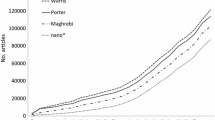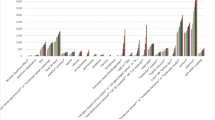Abstract
This article examines the cognitive evolution and disciplinary diversity of nanoscience/nanotechnology (nano research) as expressed through the terminology used in titles of nano journal articles. The analysis is based on the NanoBank bibliographic database of 287,106 nano articles published between 1981 and 2004. We perform multifaceted analyses of title words, focusing on 100 most frequent words or phrases (terms). Hierarchical clustering of title terms reveals three distinct time periods of cognitive development of nano research: formative (1981–1990), early (from 1991 to 1998), and current (after 1998). Early period is characterized by the introduction of thin film deposition techniques, while the current period is characterized by the increased focus on carbon nanotube and nanoparticle research. We introduce a method to identify disciplinary components of nanotechnology. It shows that the nano research is being carried out in a number of diverse parent disciplines. Currently, only 5% of articles are published in dedicated nano-only journals. We find that some 85% of nano research today is multidisciplinary. The case study of the diffusion of several nano-specific terms (e.g., “carbon nanotube”) shows that concepts spread from the initially few disciplinary components to the majority of them in a time span of around a decade. Hierarchical clustering of disciplinary components reveals that the cognitive content of current nanoscience can be divided into nine clusters. Some clusters account for a large fraction of nano research and are identified with such parent disciplines as the condensed matter and applied physics, materials science, and analytical chemistry. Other clusters represent much smaller parts of nano research, but are as cognitively distinct. In the decreasing order of size, these fields are: polymer science, biotechnology, general chemistry, surface science, and pharmacology. Cognitive content of research published in nano-only journals is the closest to nano research published in condensed matter and applied physics journals.














Similar content being viewed by others
Notes
Terms nanotechnology and nanoscience are used interchangeably (often shortened to nano) to refer to a research field studying objects that have a size or structure of 1–100 nm, and we will use them in such a way in this article as well.
As explained in the introduction, this refers to research that does not belong to any other parent discipline, i.e., to nano articles published in nano journals.
Hereafter, we will refer to this combination of words and phrases as terms.
But note that we already treat QUANTUM DOT as a separate phrase.
In subsequent text, we will occasionally shorten disciplinary component by field, but the meaning should always be clear from the context.
Chemical vapor deposition is one of the techniques that have been developed to produce larger quantities of nanotubes.
References
Barben D, Fisher E, Selin C, Guston DH (2008) Anticipatory governance of nanotechnology: foresight, engagement, and integration. In: Hackett EJ, Amsterdamska O, Lynch M, Wajcman J (eds) The handbook of science and technology studies, 3rd edn. MIT Press, Cambridge, pp 979–1000
Bassecoulard E, Lelu A, Zitt M (2007) Mapping nanosciences by citation flows: a preliminary analysis. Scientometrics 70(3):859–880
Berube DM (2006) Nano-hype: the truth behind the nanotechnology buzz. Prometheus Books, Amherst
Braun T, Schubert A, Zsindely S (1997) Nanoscience and nanotechnology on the balance. Scientometrics 38(2):321–325
Callon M, Courtial JP, Turner WA, Bauin S (1983) From translations to problematic networks: an introduction to co-word analysis. Soc Sci Inf 22(2):191–235
Darby MR, Zucker LG (2003) Grilichesian breakthroughs: Inventions of methods of inventing and firm entry into nanotechnology. NBER Working Paper, No. 9825
Glänzel W, Meyer M, Du Plessis M, Thijs B, Magerman T, Schlemmer B et al (2003) Nanotechnology: analysis of an emerging domain of scientific and technological endeavour. Report of Steunpunt O&O Statistieken, Leuven
Hayles NK (2004) Connecting the quantum dots: nanotechscience and culture. In: Hayles NK (ed) Nanoculture: implications of the new technoscience. Intellect Books, Bristol, pp 11–26
Heinze T (2004) Nanoscience and nanotechnology in Europe: analysis of publications and patent applications including comparisons with the United States. Nanotechnol Law Bus 1(4):427–445
Huang C, Chen HC, Chen ZK, Roco MC (2004) International nanotechnology development in 2003: county, institution, and technology field analysis based on USPTO patent database. J Nanopart Res 6(4):325–354
Huang C, Notten A, Rasters N (2011) Nanoscience and technology publications and patents: a review of social science studies and search strategies. J Technol Transfer 36:145–172
Hullmann A, Meyer M (2003) Publications and patents in nanotechnology: an overview of previous studies and the state of the art. Scientometrics 58(3):507–527
Jacoby M (2000) New tools for tiny jobs. Chem Eng News 78(42):33–35
Jain AK, Dubes RC (1988) Algorithms for clustering data. Prentice Hall, Englewood Cliffs
Krippendorff K (2004) Content analysis: an introduction to its methodology, 2nd edn. Sage, Thousand Oaks
Latour B, Woolgar S (1986) Laboratory life: the construction of scientific facts. Princeton University Press, Princeton
Leydesdorff L (1989) Words and co-words as indicators of intellectual organization. Res Policy 18:209–223
Leydesdorff L, Zhou P (2007) Nanotechnology as a field of science: its delineation in terms of journals and patents. Scientometrics 70(3):693–713
Li X, Chen H, Dang Y, Lin Y, Larson CA, Roco MC (2008) A longitudinal analysis of nanotechnology literature: 1976–2004. J Nanopart Res 10(Supplement 1):3–22
Lucio-Arias D, Leydesdorff L (2007) Knowledge emergence in scientific communication: from “fullerenes” to “nanotubes”. Scientometrics 70(3):603–632
Meyer M (2001) Patent citation analysis in a novel field of technology: an exploration of nano-science and nano-technology. Scientometrics 51(1):163–183
Meyer M, Bhattacharya S (2004) Commonalities and differences between scholarly and technical collaboration: an exploration of co-invention and co-authorship analyses. Scientometrics 61(3):443–456
Meyer M, Persson O (1998) Nanotechnology—interdisciplinarity, patterns of collaboration and differences in application. Scientometrics 42(2):195–205
Milburn C (2004) Nanotechnology in the age of posthuman engineering: science fiction as science. In: Hayles NK (ed) Nanoculture: implications of the new technoscience. Intellect Books, Portland, pp 109–129
Milojević S (2009) Big science, nano science?: mapping the evolution and socio-cognitive structure of nanoscience/nanotechnology using mixed methods. University of California Los Angeles, Los Angeles
Milojević S (2010) Modes of collaboration in modern science: beyond power laws and preferential attachment. J Am Soc Inf Sci 61(7):1410–1423
Mody CCM (2006) Corporations, universities, and instrumental communities: commercializing probe microscopy, 1981–1996. Technol Cult 47:56–80
Monthioux M, Serp P, Flahaut E, Razafinimanana M, Laurent C, Peigney A et al (2007) Introduction to carbon nanotubes. In: Bhushan B (ed) Springer handbook of nanotechnology. Springer, Berlin, pp 43–112
Noyons ECM, Buter RK, van Raan AFJ, Schmoch U, Heinze T, Hinze S et al (2003) Mapping excellence in science and technology across Europe: nanoscience and nanotechnology. Leiden University, Leiden
NSF (National Science Foundation) (1997) “Partnership in nanotechnology” program announcement. Arlington, VA. http://www.nsf.gov/publications/pub_summ.jsp?ods_key=nsf9820
Porter AL, Youtie J (2009) How interdisciplinary is nanotechnology? J Nanopart Res 11:1023–1041
Porter AL, Youtie J, Shapira P, Schoeneck DJ (2008) Refining search terms for nanotechnology. J Nanopart Res 10(5):715–728
Provalis Research (2005) WordStat: content analysis module for SIMSTAT & QDA Minder: User’s Guide, from http://www.provalisresearch.com/Documents/wordstat51.pdf]
Rafols I, Meyer M (2007) How cross-disciplinary is bionanotechnology? explorations in the specialty of molecular motors. Scientometrics 70(3):633–650
Roco MC (2008) Possibilities for global governance of converging technologies. J Nanopart Res 10:11–29
Roco MC (2011) The long view of nanotechnology development: the national nanotechnology initiative at 10 years. J Nanopart Res 13:427–445
Roco MC, Bainbridge WS (eds) (2001) Societal implications of nanoscience and nanotechnology. National Science Foundation, Arlington
Roco MC, Bainbridge WS (2002) Converging technologies for improving human performance: integrating from the nanoscale. J Nanopart Res 4:281–295
Roco MC, Bainbridge WS (2005) Societal implications of nanoscience and nanotechnology: maximizing human benefit. J Nanopart Res 7:1–13
Roco MC, Mirkin CA, Hersam MC (2011) Nanotechnology research directions for societal needs in 2020: summary of international study. J Nanopart Res 13:897–919
Schummer J (2004a) Interdisciplinary issues in nanoscale research. In: Baird D, Nordmann A, Schummer J (eds) Discovering the nanoscale. IOS Press, Amsterdam, pp 9–20
Schummer J (2004b) Multidisciplinarity, interdisciplinarity, and patterns of research collaboration in nanoscience and nanotechnology. Scientometrics 59(3):425–463
Smith DL (1995) Thin-film deposition: principles & practice. McGraw-Hill, New York
Toumey C (2009) Plenty of room, plenty of history. Nat Nanotechnol 4:783–784
Toumey C (2010) In the footsteps of biotech. Nat Nanotechnol 5:475
Wajcman J (2008) Emergent technosciences. In: Hackett EJ, Amsterdamska O, Lynch M, Wajcman J (eds) The handbook of science and technology studies, 3rd edn. MIT Press, Cambridge, pp 813–816
Weber RP (1990) Basic content analysis, 2nd edn. Sage, Newbury Park
Youtie J, Shapira P, Porter A (2008) Nanotechnology publications and citations by leading countries and blocs. J Nanopart Res 10:981–986
Zucker LG, Darby MR (2005) Socio-economic impact of nanoscale science: initial results and NanoBank. NBER Working Paper 11181
Zucker LG, Darby MR (2007) Nanobank Data Description release 2.0 (beta-test). UCLA Center for International Science, Technology and Cultural Policy and Nanobank, Los Angeles, 17 Jan 2007–2 Feb 2009
Zucker LG, Darby MR, Furner J, Liu RC, Ma H (2007) Minerva unbound: knowledge stocks, knowledge flows and new knowledge production. Res Policy 36(6):850–863
Acknowledgments
Certain data included herein are derived from NanoBank (Lynne G. Zucker and Michael R. Darby, NanoBank Data Description, release 1.0 (beta-test), Los Angeles, CA: UCLA Center for International Science, Technology, and Cultural Policy and NanoBank, January 17, 2007). Certain data included herein are derived from the Science Citation Index Expanded, Social Sciences Citation Index, and Arts & Humanities Citation Index of the Institute for Scientific Information®, Inc. (ISI®), Philadelphia, Pennsylvania, USA: © Copyright Institute for Scientific Information®, Inc. 2006. All rights reserved.
Author information
Authors and Affiliations
Corresponding author
Rights and permissions
About this article
Cite this article
Milojević, S. Multidisciplinary cognitive content of nanoscience and nanotechnology. J Nanopart Res 14, 685 (2012). https://doi.org/10.1007/s11051-011-0685-4
Received:
Accepted:
Published:
DOI: https://doi.org/10.1007/s11051-011-0685-4




